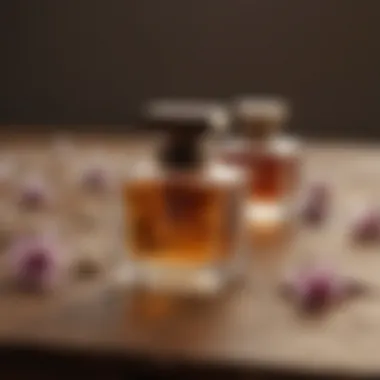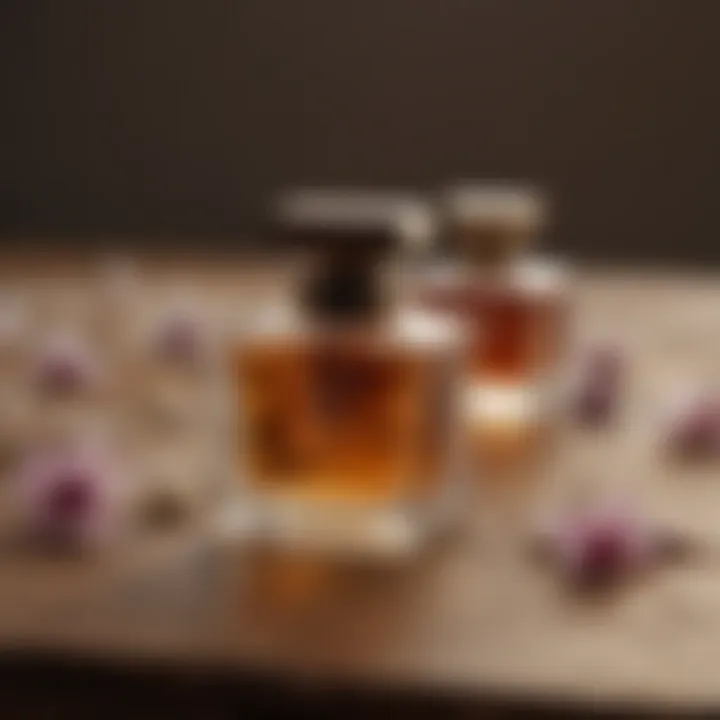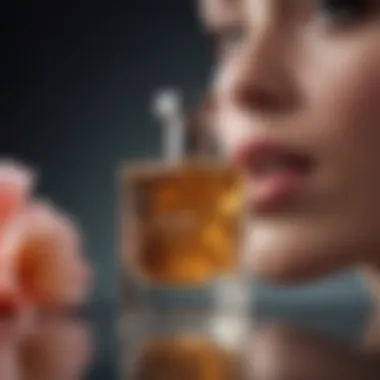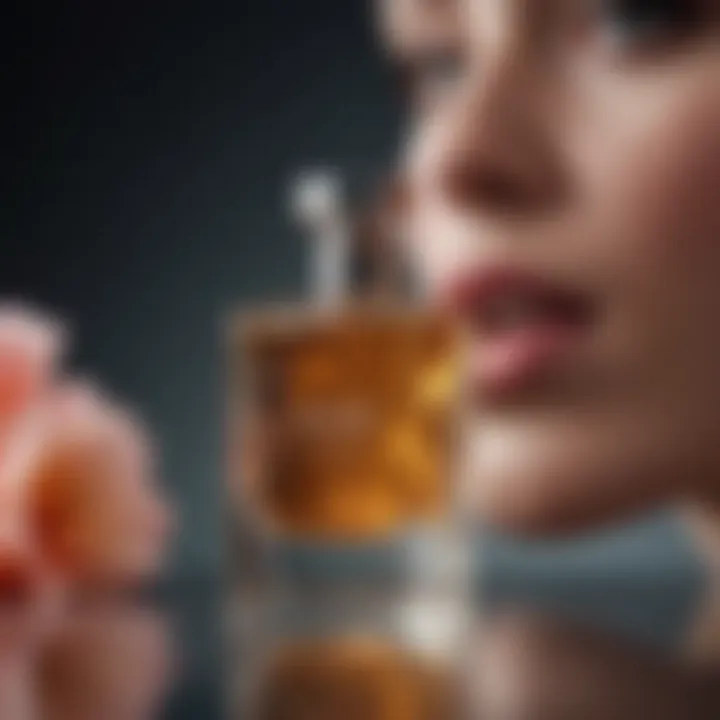Understanding Perfume Longevity: How to Choose Lasting Scents


Intro
Perfume is more than just a fleeting whiff of a scent; it's an extension of our identity, a memory in a bottle. Each fragrance tells a story, wrapping itself around us like a well-fitted garment, yet how long that narrative lingers on our skin is a complex interplay of several elements. This exploration into the longevity of perfumes sheds light on essential factors that can enhance or compromise the presence of a fragrance, informing both seasoned enthusiasts and casual dabblers in the world of scents.
Understanding the basic structure of a perfume plays a pivotal role in deciphering its lasting qualities. Essentially, perfumes consist of top, middle, and base notes. The top notes create the initial impression, but they fade relatively quickly, typically within the first 15 minutes. The middle notes, known as the heart of the scent, emerge after those initial minutes and can linger for several hours. Finally, the base notes settle in, providing depth and persistence that could span over eight hours. Each of these layers behaves differently depending on numerous factors, including skin type, environmental conditions, and perfume application methods.
In the paragraphs to follow, we will dig deeper into these aspects, aiming not only to dissect the anatomy of fragrance longevity but also to curate a practical guide that allows readers to choose wisely when it comes to their signature scent. Whether you're on the hunt for a long-lasting perfume or simply curious about what causes it to either fade quickly or endure the day, this guide will serve you well.
Understanding Perfume Composition
To grasp why certain fragrances linger longer than others, it’s essential to dive into the nuts and bolts of perfume composition. Many people might think that all perfumes are created equal, but this couldn’t be further from the truth. Each fragrance is a carefully crafted blend, much like a fine dish, and understanding its components can lead you to a lasting aroma.
The structure of perfume can be likened to a well-structured symphony. It has layers that come together to create a harmonious scent experience. The initial impressions, the heart of the fragrance, and the lingering notes that leave a lasting memory are all vital elements. By being aware of these components, you can make informed choices about which scents are likely to suit your personal preferences and needs.
There are multiple benefits to understanding perfume composition. For one, it equips you with knowledge to select fragrances that will resonate with your skin chemistry, leading to better longevity. Additionally, awareness of the types of notes in perfume can help you appreciate the art of perfumery. Each ingredient plays a distinct role and contributes to the overall wearability of a scent.
In this article, we’ll peel back the layers and examine the structure of perfume, along with the nuances of fragrance notes. This insight isn’t just for the perfume aficionado; it’s for anyone who’s ever spritzed on a scent and wished it lasted just a bit longer.
The Structure of Perfume
Perfumes are more than just a delightful bouquet of scents; they have a structure that dictates how they smell at any given time. At its core, every fragrance is a combination of various scented oils suspended in alcohol and water. This structure is key to understanding how long a perfume can last on your skin.
Perfumes are generally structured into three main layers, or what many refer to as the 'notes' of a fragrance. Each layer presents itself at different stages as the perfume interacts with your skin and the environment around you.
Types of Fragrance Notes
When diving deep into perfume composition, it's crucial to familiarize yourself with the three major types of fragrance notes: top notes, middle notes, and base notes. Each of these notes has a unique role and contributes to the overall lifespan of the fragrance on your skin.
Top Notes
Top notes are like the opening act of a concert; they are the first scents you experience upon spritzing a fragrance. These notes tend to be light and volatile, evaporating quickly. Citrus scents such as lemon or bergamot, alongside fresh herbs like mint, are prime examples of top notes. Their key characteristic is their ability to provide an immediate, uplifting burst of fragrance, which is why they are often popular choices for perfumes aiming for a refreshing start.
However, due to their fleeting nature, their longevity is quite short. They typically last anywhere from 5 to 30 minutes, which might seem like a downside, but this quick evaporation paves the way for the more complex heart of the fragrance to emerge.
Middle Notes
Middle notes come into play as the initial burst of top notes fades. They represent the fragrance's 'heart' and typically emerge around 20 minutes after application. Scents like jasmine, rose, and lavender are common examples. The key characteristic of middle notes is they create a balance, blending seamlessly with both top and base notes.
What makes middle notes significant is their longevity; they tend to last several hours, serving as the fragrance's core. However, if you’re looking for a perfume that makes a lasting statement, it’s important to pay attention to how well a fragrance transitions from top to middle notes.
Base Notes
Base notes are the backbone of any fragrance, revealing themselves after the perfume has been on skin for a while. These notes are characterized by their deep and rich aromas, like vanilla, sandalwood, and musk. Their endurance is unmatched, often lingering for over six hours or even longer.
A key aspect of base notes is their role in anchoring the fragrance. They provide depth and warmth and can influence how the scent develops over time. While not typically noticeable immediately, they are crucial for making a perfume memorable. They offer lasting power, ensuring that your chosen scent remains with you long after the initial spray.
In summary, understanding the structure and types of fragrance notes is foundational for exploring the longevity of scents. Being aware of how these components interact can empower you to select perfumes that align with your expectations for longevity and wearability. The next sections will further explore factors influencing this longevity, allowing readers to refine their fragrance choices even further.
Factors Influencing Longevity
Understanding the longevity of perfume scents is not just a trivial pursuit. The time a fragrance lasts on your skin is influenced by a myriad of factors — some inherent to the perfume itself, while others are tied to the individual and their environment. Recognizing these influences can significantly enhance your fragrance experience by helping you select perfumes that will not only smell great upon application but will also linger throughout the day. It’s thought that specific elements like skin chemistry, environmental conditions, and fragrance concentration all play vital roles in the scent’s overall lifespan.
Skin Chemistry
Every person's skin has a unique chemistry that can dramatically affect how a fragrance develops over time. Factors such as body temperature, pH levels, and even diet can alter the way a scent unfolds, making this aspect very personal and complex. For instance, someone with oily skin might find that aromas last longer compared to someone with dry skin. The oils on the skin can help to bind the fragrance, enhancing projection and longevity. Moreover, hormonal changes, genetic predisposition, and even the presence of medication can lead to variances in skin chemistry, making it essential to try fragrances on your own skin before making a purchase.
Environmental Conditions
The environment in which a perfume is worn can significantly influence its duration and projection. Let’s delve deeper into three main aspects of environmental conditions.
Temperature
Temperature is a crucial factor in how fragrances last. Warmer temperatures tend to amplify scents, making them evaporate more quickly. This can be a double-edged sword. On one hand, a warm body temperature can enhance the freshness of lighter scents; on the other, powerful fragrances may dissipate faster. In hot weather, it's often advised to wear lighter fragrances optimally suited for summery days, while heavier scents can drown in the heat.


Humidity
Humidity can also affect fragrance longevity in a unique way. High humidity can cause a scent to bloom more fully and appear vibrant, but it may also cause the top notes to weaken faster as they interact with moisture in the air. Consider this: wearing a rich, woody scent in a humid environment may lead to a pronounced yet fleeting aromatic experience. Conversely, in drier climates, fragrances tend to hang on for longer periods, making it advantageous to choose them accordingly.
Air Quality
Air quality is yet another piece of the puzzle in how perfumes last. Pollutants and airborne particles can interact with the fragrance molecules, which makes it crucial to consider one’s surroundings when applying scents. For instance, in areas with high pollution, fragrances might not only be masked but can also degrade faster, diminishing their overall impact. Thus, keeping an eye on air quality can contribute immensely to the choice of fragrances.
Fragrance Concentration
The concentration of a fragrance is directly proportional to its longevity. The higher the concentration of fragrance oils, the longer it lasts. Here’s an exploration of three common categories.
Eau de Toilette
Eau de Toilette, often considered a lighter option, contains a lower concentration of fragrance oils. This concentration typically ranges from 5% to 15%, making it a popular choice for everyday wear. While it may not sstay on the skin as long as stronger formulations, it's refreshing and suitable for casual occasions. The downside is that you might find yourself needing to reapply throughout the day, especially for a long one.
Eau de Parfum
Eau de Parfum presents a stronger alternative, with a fragrance oil concentration of 15% to 20%. This option provides a richer scent experience and tends to last longer compared to Eau de Toilette, often sticking around for an entire evening out. While it offers greater longevity, it might not be as versatile for daytime wear, where a lighter touch might be more favorable.
Perfume Oils
Perfume oils are often the most concentrated form, containing upwards of 20% to 30% fragrance oils. These oils provide an intense scent experience while clinging to the skin with remarkable longevity. Because they lack alcohol, they can be a good option for those with reactive skin. However, their potency may come with a more limited range of wear due to their strong presence, which can be overwhelming when not applied judiciously.
"Understanding the interplay of skin chemistry, environmental conditions, and fragrance concentration can help you make more informed choices about your perfume selections."
In short, recognizing and considering these factors will empower you in your journey to find fragrances that not only appeal to your senses but also resonate with your lifestyle.
Popular Long-Lasting Perfumes
When we delve into the world of perfumery, understanding which fragrances endure the test of time helps individuals make wiser choices. Popular long-lasting perfumes not only provide a delightful aroma but also save one from the constant need to reapply. This segment serves as a guide, spotlighting some of the most sought-after scents that are known for their impressive longevity.
These selections take into account various facets such as unique compositions, targeted users, and the general buzz surrounding them. It's crucial to recognize how these fragrances stand out in a competitive market, making them favorites among enthusiasts and casual users alike.
Fragrances for Women
Chanel No.
Chanel No. 5 is an iconic scent that has stood the test of time since its launch in 1921. Its contribution to the world of perfumery is monumental, establishing a benchmark for floral fragrances. The notable characteristic of Chanel No. 5 is its complex blend of jasmine and rose, which gives it depth and character. This fragrance remains a beneficial choice for anyone looking to invest in a lasting scent.
What makes Chanel No. 5 unique is its ability to evoke a sense of elegance and timelessness. It tends to linger long after application, which can be a double-edged sword — some may find it a bit overwhelming if overapplied. The discrete power it possesses allows wearers to leave a subtle yet distinct mark in any setting, be it an office or a glamorous event. However, enthusiasts must consider the hefty price tag that accompanies this legendary fragrance.
Yves Saint Laurent Black Opium
Yves Saint Laurent Black Opium is a modern classic that redefined the gourmand trend in perfumery. Its unique composition revolves around a coffee accord, which is perfectly highlighted by notes of vanilla and white flowers. This characteristic provides an alluring and bold representation, making it a popular selection in any fragrance collection.
The standout feature of Black Opium is its seductive essence, which captivates those who encounter its delightful allure. Its longevity is often praised, allowing wearers to enjoy its rich scent for hours without needing a touch-up. However, some may find its sweetness to be a bit cloying after prolonged wear, thus, it’s best suited for evening engagements or colder seasons.
Fragrances for Men
Dior Sauvage
Dior Sauvage has garnered a massive following since its release and is known for its raw freshness. The scent is celebrated for its aromatic and woody characteristics, combining notes of bergamot, pepper, and Ambroxan. This blend not only adds complexity but also assures remarkable longevity, marking it as a top choice for men.
A key aspect of Dior Sauvage is its versatility, as it can be worn effortlessly from day to night. Its unique feature lies in the vibrant citrus top notes that gradually dry down to warm earthiness, creating an intriguing scent evolution. While it enjoys rave reviews, some individuals may perceive it as slightly common given its popularity, making it a less interesting choice for those seeking uniqueness.
Creed Aventus
Creed Aventus stands as a formidable contender in the realm of luxury fragrances. Celebrated for its bold representation of strength and sophistication, Aventus combines fruity notes like pineapple and apple with a strong base of oakmoss and musk. This complexity is not just pleasing to the nose but also ensures a lasting impression throughout the day.
The unique feature of Creed Aventus lies in its high-quality ingredients, lending to an unmistakable elegance that many aspire to possess. Despite its impressive formulation, the price can deter some potential buyers, making it a niche product for dedicated fragrance connoisseurs.
In summary, popular long-lasting perfumes provide not only a memorable aroma but also encapsulate an individual’s personality and style. Choosing the right scent can be a blend of personal preference and awareness of longevity features.
Application Techniques for Longevity


Understanding how to properly apply perfume is essential in maximizing its longevity. While the intrinsic qualities of a fragrance play a critical role, these application techniques can significantly influence how long a scent lasts on your skin and in the air around you. It's not merely about where you spray; it also encompasses how various surfaces react to fragrance. Applying perfume thoughtfully can transform an ordinary fragrance experience into one that lingers and captivates. Here we delve into several effective techniques that can elevate your scent game.
Pulse Points
Pulse points are areas of the body where the blood vessels are closer to the skin's surface. These spots are notably warmer than the rest of the body, which helps to amplify and release scents more effectively. Key pulse points include:
- Wrists: A classic choice for application. When you rub your wrists together, it can diminish the aroma, so it’s better to apply and let it dry naturally.
- Behind the ears: The warmth and closeness to the face make this spot a fantastic amplifier for your signature scent.
- Base of the throat: This area offers a subtle yet constant scent release as the warmth escapes, especially if you're wearing a collar or a scarf.
- Inside elbows: Surprisingly effective, as these areas often stay warmer throughout the day.
Tip: To ensure a lasting effect, consider applying a scent-free lotion on these areas before fragrance application. This creates a barrier that enhances scent adhesion.
Clothing and Hair
Clothes and hair can absorb and retain fragrances very well, making them suitable candidates for perfume application. Spraying scent directly onto fabric can extend its lingering power. However, consider the following:
- Fabric choice: Natural fibers, such as cotton or wool, can hold scents longer than synthetic fabrics. You might want to try spritzing on a cashmere scarf or silk blouse.
- Avoid staining: Always do a patch test on small areas to avoid potential stains or discoloration, especially with darker fabrics.
- Hair absorbs well: Spraying on hair can help carry the scent throughout the day, but be cautious of strong alcohol contents in perfumes that might dry your hair. A light mist directed from a distance can be effective.
Layering Scents
Layering scents is an advanced technique that involves combining different fragrances to create a unique scent profile tailored to your personal taste. This method can result in an enduring aroma that sets you apart. Here’s how to do this effectively:
- Choose complementary fragrances: Start by selecting fragrances that share similar notes. For example, a floral scent might blend well with a light citrus. This helps avoid dissonance, which can be displeasing.
- Begin with a base layer: Use a long-lasting scent as a base and build upon it with lighter, more volatile fragrances. That way, even as the top notes dissipate, the base remains strong and consistent.
- Use unscented products: When layering with creams or lotions, opt for unscented ones to avoid clashing odors.
- Experiment carefully: Don’t rush this process. It often takes a few tries to hit the right combination that works for you.
"Layering fragrances opens a new world of possibilities, allowing you to develop a signature scent that evolves with your mood and environment."
By implementing these application techniques, fragrance enthusiasts can enhance the longevity of their chosen scents significantly. Thoughtful application not only improves how long a fragrance lasts but also influences how it is perceived by those around you. Each technique has its merits and will yield different results depending on individual preferences and environmental factors.
The Role of Ingredients
The ingredients within a perfume play a pivotal role in shaping its scent profile and longevity. When we think of a fragrance, it’s easy to overlook the composition, focusing instead on its smell or how it makes us feel. However, understanding how these elements interact with one another and with our skin can unveil much about why some scents endure longer than others.
Natural vs. Synthetic Ingredients
There’s a longstanding debate in the perfume industry about natural ingredients and their synthetic counterparts. Natural ingredients, such as rose absolute or sandalwood oil, come from plants and flowers. They are often praised for their complexity and depth. Many enthusiasts argue that natural scents bring a sense of authenticity, evoking memories of nature. However, natural materials can also be volatile, meaning they may not last long in their fragrance form. This is where synthetic ingredients step in.
Synthetic compounds, derived from chemicals rather than plants, can replicate the scent of naturals and often offer superior longevity. They can endure heat, humidity, and the body’s chemistry much better than their natural counterparts would. In addition, synthetic materials can be produced in larger quantities, making fragrances more accessible and often more affordable.
"The choice between natural and synthetic isn't just about preference; it's about understanding what you want in a scent experience."
When considering fragrance longevity, the breadth of both natural and synthetic ingredients shows that blending them can lead to intriguing, lasting compositions. A perfume with both potentially benefits from the rich aroma of natural oils alongside the endurance of synthetic materials.
Essential Oils and Their Impact
Essential oils hold a distinctive place in perfumery. These concentrated extracts from plants come laden with not only fragrance but also characteristics that can affect how a scent develops on the skin. Take lavender, for instance. It may start with a fresh, herbaceous note but evolves into a more calming scent that can linger. This transformation can impact the perception of a perfume’s longevity.
Moreover, essential oils often have therapeutic properties, adding another layer to the experience of wearing a fragrance. Patchouli, known for its earthy aroma, can evoke grounding feelings; meanwhile, bergamot can uplift the spirit. The way these elements interact with our skin chemistry can establish different longevity outcomes. A blend incorporating high-quality essential oils may provide a longer-lasting experience if balanced correctly with other components.
Cultural Perspectives on Perfume Use
Perfume is not just a scent; it is a cultural artifact, deeply embedded in the rituals, social codes, and historical narratives of various societies. In this article, we shine a light on how different cultures approach the use of fragrances, how these practices influence perceptions of longevity, and the significance of scent in articulating identity.
Fragrance often plays a critical role in social interactions and cultural celebrations. In many cultures, perfumes are tied to personal identity and memory. The olfactory senses can evoke nostalgia or signify status. This cultural component becomes particularly relevant when discussing longevity. When a scent resonates with cultural expectations or personal significance, it sticks around both in memory and on the skin.
Historical Significance
Diving into the depths of history, perfume has roots stretching back thousands of years. Ancient Egyptians, for example, utilized fragrant oils and incense in religious practices and daily life. They believed that scents could connect the terrestrial to divine realms. The practice was not merely about enjoying a pleasing aroma; it functioned as an offering to the gods.
Additionally, during the Renaissance, perfume gained a foothold in European courts. It signified wealth and sophistication. The use of elaborate scent combinations would often reflect one's position in society. The fragrances were crafted with the finest resources, incorporating rare ingredients, hinting at a status that was lasting, just like the scents themselves.
Given this historical backdrop, longevity was as much a matter of prestige as it was of enjoyment. A fragrance that lingered could speak volumes about one’s social and economic standing.
Modern Trends
Today, the conversation around perfume use has shifted to encompass not only aesthetics but also ethics and health. The sustainable movement influences modern perfumery, with consumers increasingly favoring brands that prioritize eco-friendly practices. This trend reflects a broader societal shift towards valuing not just how a scent lingers on the skin, but how the ingredients are sourced and processed.


Furthermore, personal expression plays a significant role in contemporary fragrance choices. Many individuals now seek out signature scents that tell their unique stories rather than simply following trends. These modern approaches can lead to perfumes that resonate profoundly with users, making them feel a connection that enhances the perceived longevity of their favorites.
Interestingly, the rise of digital platforms for fragrance sampling and reviews has opened doors for exploring new scents. Communities on Reddit and Facebook share insights into combinations and preferences, creating a cultural exchange around perfume that adds to the wealth of knowledge on what makes a scent stick.
Ultimately, recognizing the cultural perspectives on perfume illuminates the broader implications regarding scent in our lives. It goes beyond the mere nose; it encapsulates identity, history, and modernity, illustrating how fragrance is interwoven into the social fabric and personal experiences.
Personal Preferences and Longevity
When discussing the longevity of perfume scents, personal preferences are central to the conversation. Each individual’s unique tastes and affinities play a pivotal role in determining not just which fragrances they gravitate towards, but also how those scents perform on their skin. It's not merely a matter of scent; it’s an exploration of identity, mood, and expression.
Understanding the nuances of one’s fragrance preferences can notably enhance the olfactory experience. For instance, some folks might prefer floral or fruity notes, while others are drawn to woodsy or spicy undertones. This difference in preference influences how a fragrance interacts with skin chemistry, ultimately affecting longevity. Individuals with a penchant for heavier, more robust scents, like those dominated by sandalwood or patchouli, might find they last longer than lighter citrus fragrances, which can dissipate quicker, sometimes within the hour.
Investing time in identifying what scents speak to you is essential. It’s not uncommon for people to cycle through many fragrances in an attempt to find the one that resonates most deeply. Finding your signature scent can lay the groundwork for a more satisfying fragrance journey that transcends mere trends, drawing on what you truly enjoy.
Finding Your Signature Scent
Selecting a signature scent involves more than just picking a pleasant aroma. It’s about understanding how certain notes harmonize with your skin and reflect your personality. Consider attending fragrance houses or stores where testers are ample and exploratory.
- Understand Yourself: Reflect on scents that evoke memories or emotions. Perhaps a warm vanilla reminds you of childhood baking, or a fresh ocean breeze ties back to summer vacations. These connections help narrow down choices effectively.
- Skin Chemistry Matters: How a scent interacts with your unique body chemistry can make or break its longevity. Test perfumes on your skin rather than paper strips. Notice how they develop over time.
- Trial and Error: Sometimes it's like dating. You have to meet a few “scents” before finding one that feels just right. This journey can be enlightening, offering snippets of knowledge about various fragrance families and their characteristics.
Experimenting can become a delightful exploration of olfactory spaces filled with stories and personal signatures.
Experimenting and Sampling
Sampling various scents is both fun and enlightening. This practice allows you to discover new favorites and understand what lasts. Some practical tips include:
- Fragrance Wardrobe: Develop a small collection of scents for different occasions. You might find a fresh citrus scent perfect for day-to-day wear, while a bold woody fragrance suits evenings out.
- Seasonal Scents: Just like an outfit, scents can have a seasonal aspect. Warm, rich scents might feel right in winter, whereas lighter, floral fragrances can lift spirits in summer.
- Visit Scent Events: Perfume museums, or fragrance exhibitions often showcase lesser-known artisans and niche brands. Explore these settings! They provide you a chance to sample a variety of unique scents that might not be in mainstream circulation.
Ultimately, discovering personal preferences and their connection to fragrance longevity enriches the entire experience of wearing a perfume. The process is as much about self-discovery as it is about scent, providing a more intimate relationship with the essence you wear.
Common Misconceptions About Perfume Longevity
Understanding the common misconceptions about perfume longevity is essential for both enthusiasts and casual users. Many people fall prey to certain myths that cloud their judgment when selecting fragrances. These misconceptions can lead to disappointments, where a fragrant promise fails to deliver, leaving the wearer frustrated or feeling misled. Moreover, uncloaking these myths enhances one’s ability to choose the right perfume that stays true to its bouquet well beyond a few fleeting moments.
Myths Clarified
Perfume longevity is often shrouded in misunderstandings that can affect purchasing decisions. Let’s look at some prevalent myths:
- Myth 1: All perfumes are the same. Not all perfumes are created equal. From high-end designer scents to mass-market options, the concentration of fragrance oils varies.
- Myth 4: Fragrance type guarantees duration. Just because a fragrance is labeled as "eau de parfum" doesn’t assure that it will last longer than an "eau de toilette." Different compositions play a crucial role.
- Myth 2: Fragrance strength equals longevity. Stronger scents do not always mean longer-lasting ones. Some bold fragrances can dissipate quickly because of their volatile top notes.
- Myth 3: You only need to apply perfume once a day. Many believe that a single application suffices. However, personal skin chemistry plays a role, and frequent reapplication may be necessary.
"The scent is not just what you wear; it’s about how it's woven with your own essence and life."
Debunking these myths brings clarity and helps consumers approach their fragrance choices with knowledge rather than assumptions. For example, understanding that a light, floral scent may last shorter than an amber or woody base can help one opt for richer profiles for those days when longer wear is desired. Additionally, recognizing one’s skin chemistry and environmental factors might influence longevity ensures that wearers don’t base their perfume experience solely on marketing hype.
This section not only clarifies what scent longevity should look like but also empowers readers with intelligence on how to navigate their fragrance-joint journey. Taking the time to unravel these misconceptions leads to a more informed and satisfying scent selection process.
Ending and Final Thoughts
As we draw the curtain on our exploration of fragrance longevity, it’s crucial to reflect on the intricate dance of science and artistry that perfumes embody. The ability of a scent to linger speaks volumes not just about its composition, but also about the wearer’s personal chemistry, lifestyle, and choose of application. This topic moves beyond mere preference—tapping into emotional connection, memories, and even cultural significance.
One cannot underestimate the countless hours perfumers invest in crafting fragrances that don’t just smell wonderful but also last long. Understanding the subtleties behind top, middle, and base notes becomes more than just knowledge; it’s the key to unlocking a scent’s potential. Each layer plays a distinct role in how a fragrance evolves on the skin over time, and recognizing this can elevate a fragrance from ordinary to unforgettable.
Benefits of Choosing Long-Lasting Fragrances
When shopping for a perfume, opting for long-lasting options can enhance your overall experience. These scents find their way to the core of an event or occasion, a whispered reminder of the moments shared. With the right fragrance that lasts, individuals can maintain a signature presence, leaving an impression that lingers well after they have left the room.
Considerations About Longevity
However, one must also take stock of personal factors. How skin type interacts with different notes and blends is particularly important. Factors such as hydration, diet, and even the pH of the skin can alter how a perfume sits. Moreover, environmental conditions, like humidity and heat, work their own magic in either preserving or dissipating scents. Knowing your unique skin chemistry allows for a sharper, more informed choice.
In essence, considering all these facets makes the process both an art and a science—a multifaceted journey in selecting the right fragrance. It reveals an individual’s personality and serves as a form of self-expression.
As we conclude, remember this: it’s not just the length of time a scent lasts that matters, but how well it resonates with you and those around you. Finding a fragrance that embodies your essence might just be the most lasting impression of all.
"Perfume is the most intense form of memory." - Jean-Paul Guerlain
Key Takeaways
- Perfume Longevity relies on multiple factors including skin chemistry, environmental conditions, and scent composition.
- Long-lasting fragrances can enhance your overall presence and contribute to lasting memories.
- Personal factors must be considered to find a fragrance that resonates uniquely with you.
- Understanding fragrance notes can greatly improve the fragrance selection process.















